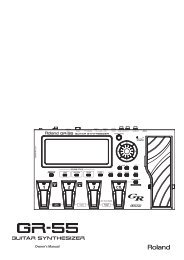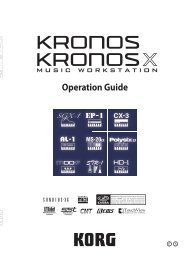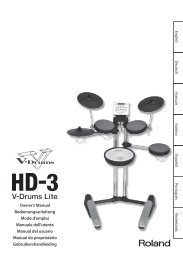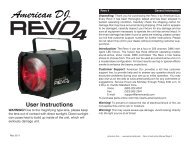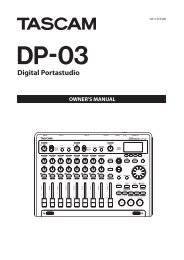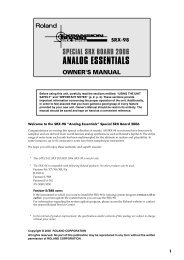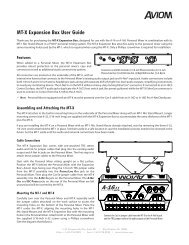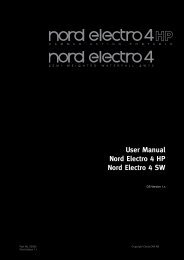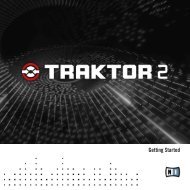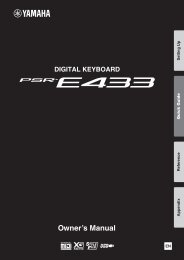Korg Microkorg Owner's Manual - zZounds.com
Korg Microkorg Owner's Manual - zZounds.com
Korg Microkorg Owner's Manual - zZounds.com
Create successful ePaper yourself
Turn your PDF publications into a flip-book with our unique Google optimized e-Paper software.
MIDI on the microKORG<br />
a second time. To prevent each note from being sounded twice, once directly from<br />
the keyboard and once from the echoed-back note, you must turn the microKORG's<br />
Local Control setting off.<br />
Recording the MIDI output from the microKORG's arpeggiator<br />
onto an external MIDI sequencer or <strong>com</strong>puter<br />
Connect the microKORG's MIDI OUT connector to the MIDI IN connector of your<br />
external MIDI sequencer / <strong>com</strong>puter, and connect the microKORG's MIDI IN<br />
connector to the MIDI OUT connector of your external MIDI sequencer / <strong>com</strong>puter.<br />
(➝p.49)<br />
Then turn the microKORG's Local Control off (MIDI "LOCAL" OFF), and turn on<br />
the echo back setting of your external MIDI sequencer / <strong>com</strong>puter.<br />
Recording the note data from the arpeggiator onto an external MIDI sequencer /<br />
<strong>com</strong>puter<br />
Set the microKORG's GLOBAL "POSITION" to Post KBD ( ).<br />
Turn on the microKORG's arpeggiator, play the keyboard, and record the note data<br />
on your external MIDI sequencer / <strong>com</strong>puter. If the GLOBAL "POSITION" is set to<br />
Post KBD, the MIDI note data produced by the arpeggiator will be output from the<br />
microKORG, and recorded. (➝p.47)<br />
Turn the microKORG's arpeggiator off during playback.<br />
Recording only the arpeggio-triggering notes on an external MIDI sequencer /<br />
<strong>com</strong>puter, and running the microKORG's arpeggiator during playback<br />
Set the microKORG's GLOBAL "POSITION" to Pre TG ( ).<br />
Turn on the microKORG's arpeggiator, play the keyboard, and record the note data<br />
on your external MIDI sequencer / <strong>com</strong>puter. If GLOBAL "POSITION" is set to Pre<br />
TG ( ), only the notes you actually play on the keyboard will be transmitted as<br />
MIDI data, and the MIDI note data generated by the arpeggiator will not be<br />
transmitted. However, the MIDI note data echoed back from the external MIDI<br />
sequencer / <strong>com</strong>puter (whose echo back setting is turned on) will trigger the<br />
microKORG's arpeggiator, producing an arpeggio. (➝p.47)<br />
Turn the microKORG's arpeggiator on during playback.<br />
Synchronizing the arpeggiator<br />
The MIDI "CLOCK" setting specifies whether the microKORG's arpeggiator will be<br />
the master (the controlling device) or slave (the controlled device).<br />
For information on synchronization-related settings of your external MIDI<br />
device, refer to the manual of your device.<br />
Using the microKORG as master and the external MIDI device as slave<br />
Connect the microKORG's MIDI OUT connector to the external MIDI device's MIDI<br />
IN connector (➝p.48). If you set MIDI "CLOCK" to Internal ( ), the microKORG<br />
will be the master, and will transmit MIDI timing clock messages.<br />
Make settings on your external MIDI device so it will receive external MIDI clock<br />
data. The external MIDI device (sequencer, rhythm machine, etc.) will operate at the<br />
tempo specified by the ARPEG.A "TEMPO" setting.<br />
Using the external MIDI device as master and the microKORG as slave<br />
Connect the microKORG's MIDI IN connector to the external MIDI device's MIDI<br />
OUT connector (➝p.48). If you set MIDI "CLOCK" to External ( ), the<br />
microKORG will be the slave.<br />
The microKORG's arpeggiator will operate at the tempo of the external MIDI device<br />
(sequencer, rhythm machine, etc.).<br />
If you set MIDI "CLOCK" to Auto ( ), the microKORG will automatically<br />
function using the External setting if MIDI clock is being received from an<br />
external MIDI device connected to the MIDI IN connector. Otherwise, the<br />
microKORG will function using the Internal setting.<br />
50



